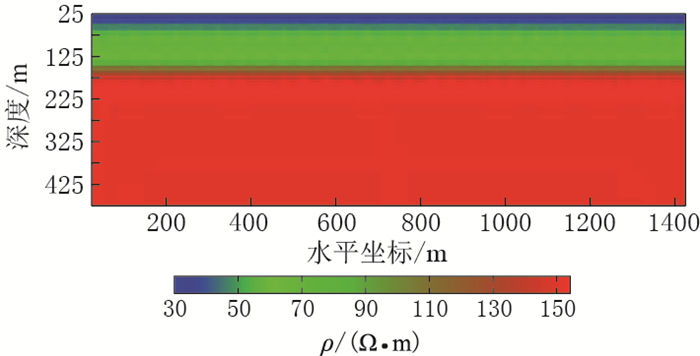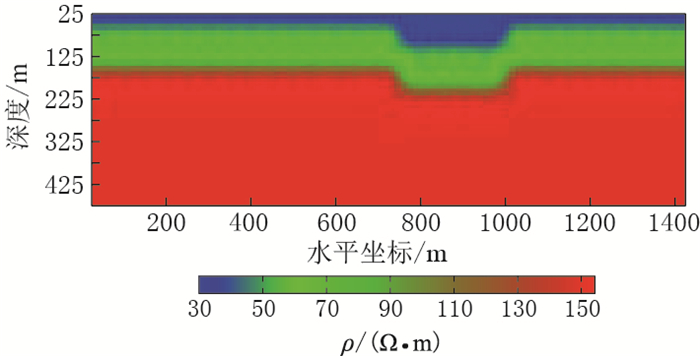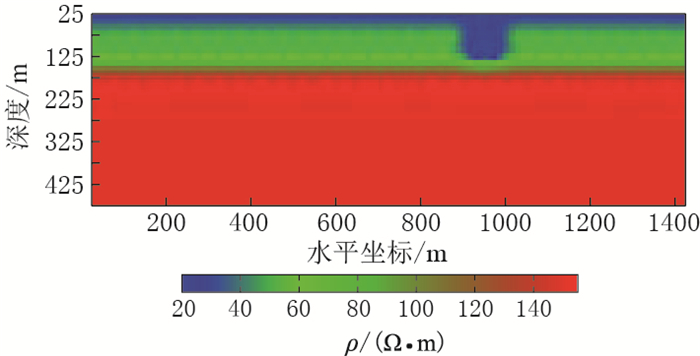Inversion of geoelectrical resistivity observed with multi-separation of electrodes
-
摘要: 地电阻率多极距观测的目的是借助对观测数据的反演获得地下介质中不同层位真电阻率的变化.本文以3层结构为例,对地电阻率多极距观测的一维反演的效果进行了初步地理论研究.首先研究了一维地电阻率结构下观测数据一维反演的模拟效果,得到了各层电阻率值,且与真电阻率值很接近,说明在地下电性结构为一维的情况下,电阻率多极距观测可以区分出不同地层的电阻率变化.其次,考虑到台址下电阻率结构的复杂性,研究了上两层界面存在起伏的情况下,多极距观测数据一维反演的效果,结果显示:当电阻率变化较小时,各层反演得到的电阻率的变化与真电阻率十分符合;当上两层介质的电阻率变化较大时,各层反演得到的电阻率出现畸变,与真实电阻率的变化情况存在一定差别,表明浅层电阻率变化达到一定程度后将会影响对深部电阻率变化情况的正确判断.一般情况下,观测的时间间隔越短,则连续两次观测时段内各层介质的电阻率变化越小,因此缩短多极距观测的时间间隔可能是避免出现上述畸变现象的有效观测手段.Abstract: Preliminary theoretical studies were dealt with in this paper on the efficiency of one-dimensional inversion of apparent resistivity data observed with multi-separation array, for understanding the true resistivity variations with time inside the media. To this end a three-layer model has been taken as an example. Firstly, we did the inversion of the theoretical apparent resistivity data by forward modeling calculation for each layer in one-dimensional resistivity structure. The result shows a good consistency between the true resistivity variations and that obtained with inversion of each layer, suggesting that one-dimensional inversion technology is adequate for recognizing the variations of resistivity in each layer. Secondly, more complex model was taken due to some interface fluctuation, which deviated from one-dimensional model to some extent. The same process of forward-inversion was conducted in the case of the fluctuation of interfaces of the three-layer model, the results showed that good fitting can be found only in the condition of non-large variations of resistivity of the first-and second-layers, otherwise the inverted resistivity of each layer will turn up distortion. Usually the shorter the time interval of observation, the smaller the medium resistivity change during the two consecutive observation. Therefore, to reduce the distortion, it could be available by taking short time interval of observation with multi-separation array.
-
-
图 3 第1,3层电阻率ρ1和ρ3变化,第2层电阻率ρ2不变时各层的多极距电阻率一维反演结果(虚线)与真电阻率(实线)的比较
Figure 3. Comparision of the resistivity by inversion with multi-separation array (dashed line) and the actual resistivity (solid line) for each layer when resistivity of the first-and third-layer ρ1 and ρ3 vary with time, but resistivity of the second-layer ρ2 remains unchanged
表 1 一维电性结构下多极距观测系统的布极参数
Table 1 The electrodes arrangement parameters of multi-separation array system in one-dimension
AB/m MN/m 30 2 100 16 270 30 500 100 1000 300 表 2 二维电性结构下多极距观测系统布极参数和针对图 5所示模型利用一维与二维正演方法计算得到的视电阻率结果对比
Table 2 The electrodes arrangement parameters of multi-separation array in two dimension and the comparision of apparent resistivities calculated from one-dimensional and two-dimensional forward modeling based on the model of Fig. 5
装置编号 AB/m MN/m 一维视电阻率
ρ1D/(Ω·m)二维视电阻率
ρ2D/(Ω·m)相对误差 C1 200 50 38.38 38.20 -0.47% C2 400 150 50.49 50.18 -0.61% C3 600 150 64.24 64.64 0.62% C4 800 250 73.58 74.08 0.68% C5 1000 350 81.46 81.02 -0.32% 注:相对误差=(ρ2D-ρ1D)/ρ1D. -
杜学彬. 2010.在地震预报中的两类视电阻率变化[J].中国科学:地球科学, 40(10): 1321-1330. http://www.cnki.com.cn/Article/CJFDTOTAL-JDXK201010004.htm Du X B. 2010. Two types of changes in apparent resistivity in earthquake prediction[J]. Science China Earth Sciences, 54(1): 145-156. http://www.cnki.com.cn/Article/CJFDTOTAL-JDXK201010004.htm
冯锐, 郝锦绮, 周建国. 2001.地震监测中的电阻率层析技术[J].地球物理学报, 44(6): 833-842. http://www.cnki.com.cn/Article/CJFDTOTAL-DQWX200106012.htm Feng R, Hao J Q, Zhou J G. 2001. Resistivity tomography in earthquake monitoring[J]. Chinese Journal of Geophy-sics, 44(6): 833-842 (in Chinese). http://www.cnki.com.cn/Article/CJFDTOTAL-DQWX200106012.htm
李艳东, 赵家骝, 庞丽娜. 2004.地电阻率多极距观测中的最佳布极方式[J].地震, 24(2): 17-24. http://www.cnki.com.cn/Article/CJFDTOTAL-DIZN200402003.htm Li Y D, Zhao J L, Pang L N. 2004. The optimal mode for arranging the electrodes for multi-spacing system in apparent resistivity observation[J]. Earthquake, 24(2): 17-24 (in Chinese). http://www.cnki.com.cn/Article/CJFDTOTAL-DIZN200402003.htm
毛先进, 鲍光淑. 1998.一种适于电阻率成像的正演新方法[J].地球物理学报, 41(增刊): 385-393. http://www.cnki.com.cn/Article/CJFDTOTAL-DQWX1998S1040.htm Mao X J, Bao G S. 1998. A new modeling method for resistivity tomography[J]. Acta Geophysica Sinica, 41(S): 385-393 (in Chinese). http://www.cnki.com.cn/Article/CJFDTOTAL-DQWX1998S1040.htm
毛先进, 钱家栋, 杨玲英. 2008.地电阻率多极距观测及研究进展[J].地震研究, 31(4): 406-412. http://www.cnki.com.cn/Article/CJFDTOTAL-DZYJ200804018.htm Mao X J, Qian J D, Yang L Y. 2008. Progress of multi-separation array observation and research for earth resistivity[J]. Journal of Seismological Research, 31(4): 406-412 (in Chinese). http://www.cnki.com.cn/Article/CJFDTOTAL-DZYJ200804018.htm
钱家栋, 陈有发, 金安忠. 1985.地电阻率法在地震预报中的应用[M].北京:地震出版社: 103-107. Qian J D, Chen Y F, Jin A Z. 1985. Application of Geoelectrical Resistivity in Earthquake Prediction[M]. Beijing: Seismological Press: 103-107 (in Chinese).
钱家栋, 赵和云. 1988.地电阻率的数值模拟和多极距观测系统[J].地震学报, 10(1): 77-89. http://www.dzxb.org/Magazine/Show?id=28238 Qian J D, Zhao H Y. 1988. Earth resistivity modeling and observational system with multi-separation of electrodes[J]. Acta Seismologica Sinica, 10(1): 77-89 (in Chinese). http://www.dzxb.org/Magazine/Show?id=28238
汪雪泉, 郑兆苾, 薛维龙. 2002.安徽嘉山台的多极距电阻率观测[J].地震学刊, 22(1): 1-4. http://www.cnki.com.cn/Article/CJFDTOTAL-DZXK200201000.htm Wang X Q, Zheng Z B, Xue W L. 2002. Multiple polar distance resistivity observation at Jiashan, Anhui seismic station[J]. Journal of Seismology, 22(1): 1-4 (in Chinese). http://www.cnki.com.cn/Article/CJFDTOTAL-DZXK200201000.htm
王兰炜, 朱旭, 朱涛, 张世中, 刘大鹏, 胡哲, 张宇. 2011.地电阻率多极距观测系统及试验研究[J].地震, 31(1): 20-31. http://youxian.cnki.com.cn/yxdetail.aspx?filename=NMHB201706095&dbname=CJFDPREP Wang L W, Zhu X, Zhu T, Zhang S Z, Liu D P, Hu Z, Zhang Y. 2011. Multi-separation array geo-electrical resistivity observation system and its experimental observation[J]. Earthquake, 31(1): 20-31 (in Chinese). http://youxian.cnki.com.cn/yxdetail.aspx?filename=NMHB201706095&dbname=CJFDPREP
薛顺章, 温新民, 董永德, 梁子彬, 张庆渊, 赵和云. 1994.地电阻率预报地震新方法的研究[J].地震学报, 16(2): 227-234. http://www.dzxb.org/Magazine/Show?id=28607 Xue S Z, Wen X M, Dong Y D, Liang Z B, Zhang Q Y, Zhao H Y. 1994. A new method for earthquake prediction by earth resistivity measurements[J]. Acta Seismologica Sinica, 16(2): 227-234 (in Chinese). http://www.dzxb.org/Magazine/Show?id=28607
张国民, 傅征祥, 桂夑泰. 2001.地震预报引论[M].北京:科学出版社: 214-270. Zhang G M, Fu Z X, Gui X T. 2001. Introduction to Earthquake Prediction[M]. Beijing: Science Press: 214-270 (in Chinese).
赵和云, 钱家栋. 1987.郫县台多极距观测资料的反演和分析[J].中国地震, 3(增刊): 73-78. http://www.cnki.com.cn/Article/CJFDTOTAL-ZGZD1987S1008.htm Zhao H Y, Qian J D. 1987. Inversion and analysis of data of temporal change in apparent resistivity with multi-separations in Pixian station, Sichuan Province[J]. Earthquake Research in China, 3(S): 73-78 (in Chinese). http://www.cnki.com.cn/Article/CJFDTOTAL-ZGZD1987S1008.htm
赵和云, 钱家栋. 1988.层状介质中膨胀球模拟力源的应力-应变场与视电阻率的关系[J].西北地震学报, 10(2): 8-21. http://www.cnki.com.cn/Article/CJFDTOTAL-ZBDZ198802001.htm Zhao H Y, Qian J D. 1988. Relationship between apparent resistivity and stress-strain field in the layer media due to an expanding sphere as a modelling earthquake source[J]. Northwestern Seismological Journal, 10(2): 8-21 (in Chinese). http://www.cnki.com.cn/Article/CJFDTOTAL-ZBDZ198802001.htm
Lu J, Xue S Z, Qian F Y, Zhao Y L, Guang H P, Mao X J, Ruan A G, Yu S R, Xiao W J. 2004. Unexpected changes in resistivity monitoring for earthquakes of the Longmen Shan in Sichuan, China, with a fixed Schlumberger sounding array[J]. Phys Earth Planet Inter, 145(1/2/3/4): 87-97. http://www.sciencedirect.com/science/article/pii/S0031920104001621
Mazzella A, Morrison F H. 1974. Electrical resistivity variations associated with earthquakes on the San Andreas fault[J]. Science, 185(4154): 855-857. doi: 10.1126/science.185.4154.855





 下载:
下载:








